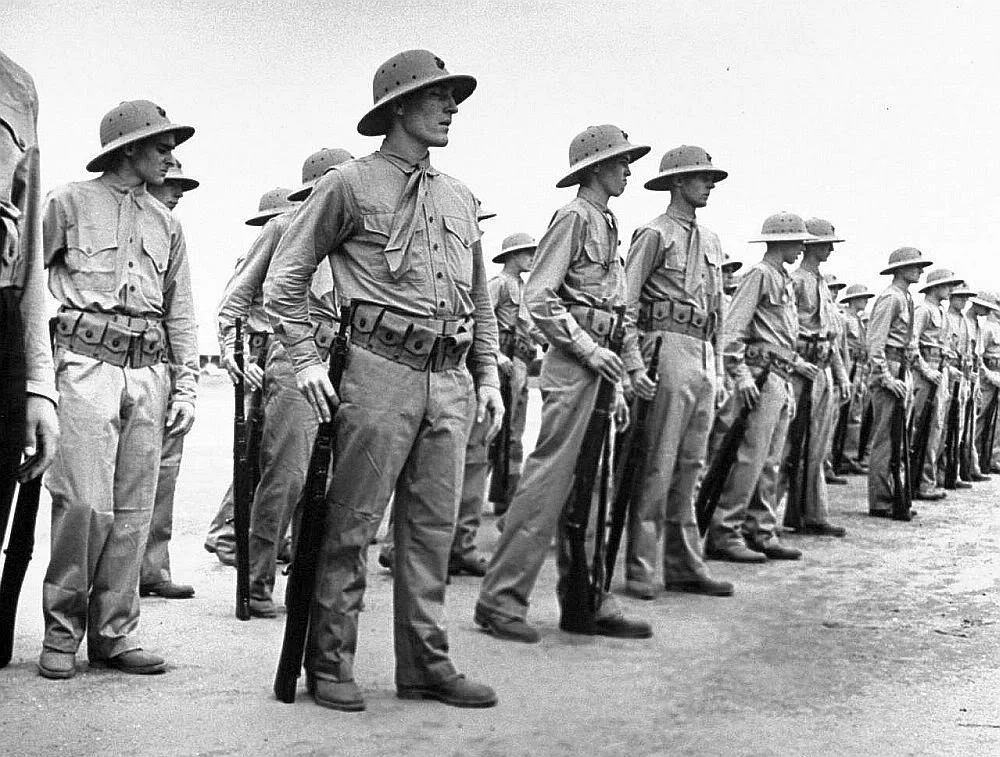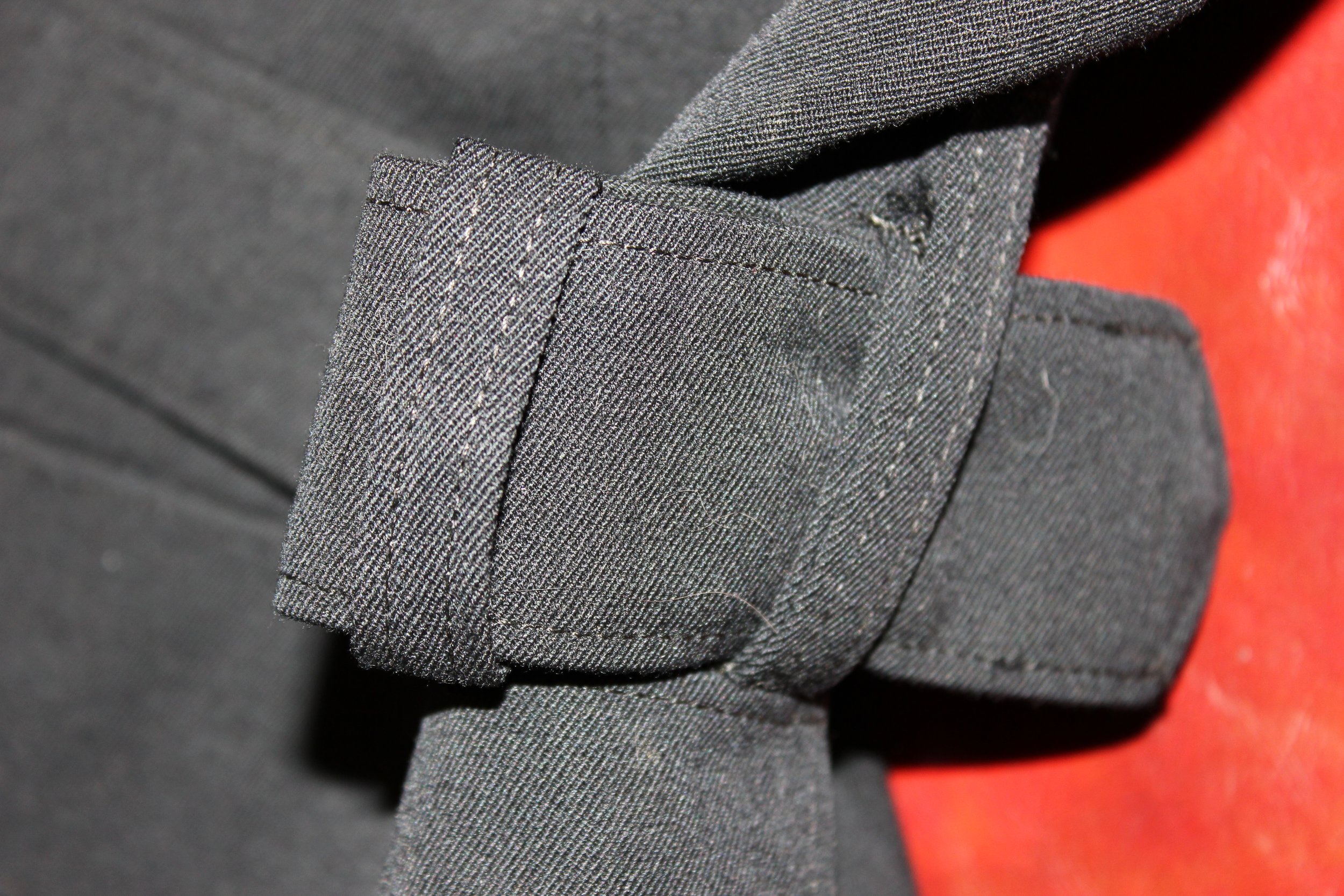Marines of WWII (Part #1)
U.S. Marine, at the start of WWII:
I think the US Marines were trained, but still sort of caught off guard when WWII broke out, and the Japanese steamroller brutally conquered a large area around Japan, and across the Pacific. It was impressive if not disturbing. The Marines were soon detailed to fight in the Pacific. The War in Europe would take much of the headlines, surprisingly, even after the Attack on Pearl Harbor in 1941. The Marines started to gear up, Those that had been in a while began to train recruits in mass, and even though they drafted young Americans into the Marines, for the first time I think it is all volunteer service, people were drawn into the armed services in record numbers, many were drafted, but many volunteered as well, it was a lot of people after the bombing of the Navy Fleet in 1941, to the point that if one was found to be 4F, and unfit to get to serve, many young men killed themselves because the were so humiliated, unbelievable nowadays perhaps, but it was not uncommon.
The Marines at places like the Philipines, Battan, Guam, Wake Island, and Midway, would be hard-pressed to stop the Japanese who outnumbered them, and had Naval and Air superiority, these Marines would suffer in mass. They fought like hell, but with old and obsolete weapons, and little, to no support, they were just left to their own. Many would be beaten and starved as POWs, decreased and murdered in mass, but some survived it all. One should read up and these battles, it was not just Marines, there were the Army Navy, and Air Corps personnel stationed there as well, and the Nurse Corp, on and on, not to mention the British (UK Forces) were catching hell as well, and even before the Americans.
But those already in the Corps had old 1903 Springfield Bot Action 30.06 Rifles, however, Marines know their weapons top to bottom and take pride in their marksmanship. The Marines would ride to war with the Navy, but then be on their own to a large extent. They would be walking over the Islands, often wearing their uniforms till they fell off of them. They would use new equipment in the way of the Higgins Boats, and LCVPs, even Tracked Vehicles (LVT) for the first time, but the learning curve would be steep, and virtually every battle had new landing vehicles! This part of the war covered a bunch of little unheard Islands, and Attols, where the Japanese had Air Bases, or would be an advantage for the Americans to use for Air Bases and harbors. But some of the lesser-known occupied islands were just bypassed, and the enemy stayed on them, after their food and water ran out, no one came to get them, and were found again in the late 1940s and into the 1950s.
Marines historically have been underdogs, kept small in size and structure, and jumped into nasty places where they will be outnumbered, or surrounded, or land on a beach and hold it, one might compare the Army’s Airborn/Rangers maybe, and really they are an element of the Navy, kind of like the Coast Guard of present, in that I mean there a Corp, not made up of numerous Armies of thousands of the troop. The Mares are a part of the Navy, but completely self-contained with their own armor and artillery support along with air, and now helicopters and the like. And they are a very unique force to have available, like a quick reaction force, not a Police Force, and not an Army, they can’t stand and hold ground taken over by the enemy, the Marines are an option for taking that ground though.
USMC, Gunnery Sergeant, Forrest-Green Dress, WWII:
This uniform is for the 1st Marine Division, the now very famous “Old Breed”, in Honor of their service. I don’t know if I have enough space for their story, a mighty proud one it is!
Marine Sergeant, Dress Blues, WWII:
The Dress Blues-the very reason many join the Marine, then find out what’s behind it all! the other half join, for personal reasons, wanting to be with other top-notch elite troops, it’s not for the food, or the sleeping conditions…but it shows just how powerful the legend is, and the mystique of the Marines, so profound that they even guard the President and the diplomats.
Marine Gunny, Dress Blues, WWII:
Most of us will never understand what it took, or take to become a Marine, they do darn well earn the title. and I can tell you the Corps is grilled into them, it is a part of their very being, and they are different than us, they were, and are willing to do things, that most of us are not. And they very much deserve our respect.
Marine 1st Lieutenant, Dress White Uniform:
3rd Marine Division WWII:
Early in the War, the Continental US could not help them, and they did their best to hold off the Japanese, It would take some time to build up the Corps to what it became, casualties were heavy, and were till the bitter end of the war.
Second Marine Division, Infantryman.
At Boganville the recapture of Buna and Gona and Guadalcanal Operations, and the Guinea Campaign, where Alstrailian Forces would carry the game. There were Gilbert and Marshall Island Campaigns in 1943–44, then there were the Maken Island Raid, Tarawa, Kwajalein, and Eniwetok, the Marianas and the Palau Islands campaigns.
III Amphibious Battalion, WWII:
It was hard-corps fighting, and following numerous battles on small forgotten atolls, and renamed islands. the price was high to win this war. In large this part of WWII has been put in a quiet part of WWII, but it was a huge part, in the way of Air, Naval, and Landing Forses it was immense, each on a scale of the Normandy Landings.
V Amphibious Battalion, WWII:
The Corp would be called on to fight in the Admiralty Islands Campaign, after the Naval battles of the Bismark Sea, on March 2, 1943, the Battle of the Philippine Sea June 19th-20th of 1944, and then at Leyte Gulf, October 23rd to 26th in 1944, leading into the Marine invasions, and battles in Saipan, Guam, and Manila ( in the Philipines).
USMC, 6th Marine Division:
The Marines would also be also involved in the Battle of Iwo Jima from February 19 to March 26, 1945, and the Battle of Okinawa, from April 1 to June 21, 1945
Typical Marine Infantryman:
USMC, Shelter Quarter, WWII:
Water-Proof Poncho:
USMC Ships Detachment WWII:
Service A (Barracks Uniform), III Marine Amphibious Corps, WW2:
Retired Commercial Fisherman, Studies Military History, Military Uniform Collector.






























































































































































































































































